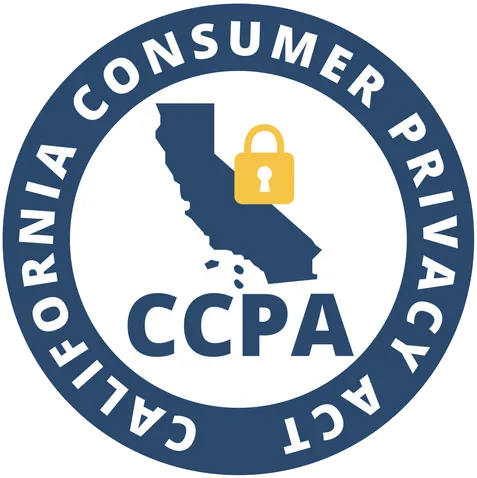A great job ad not only attracts top talent but also offers candidates a glimpse into what makes your organization unique. Job ads that include diversity statements receive 30% more applicants, and 85% of candidates consider a company’s employer brand before applying, highlighting the importance of clear and authentic messaging.[1][2] As more companies embrace AI in their hiring processes, ensuring fairness and reducing bias is critical. In the sections below, we’ll explore a variety of hiring ad examples that illustrate how modern approaches better engage today’s job seekers and help organizations stand out in a competitive talent market.
But before we take a look at the hiring ad examples, let’s cover the key points of writing a job ad.
1. Write with Clarity and Brevity
a) Start with a concise job title that reflects the role (e.g., “Senior Software Engineer”.
b) List 5–7 key responsibilities using bullet points, focusing on core tasks.
c) Specify essential qualifications (e.g., “5+ years of Python experience”)
d) Avoid vague terms like “rockstar.”
e) Keep the ad under 500 words to maintain reader's attention.
Example: Senior Backend Engineer – Payments Infrastructure
“We’re looking for a Senior Backend Engineer with 5+ years of experience in Python and PostgreSQL. You’ll design scalable APIs and build infrastructure that processes millions of transactions daily. Must be fluent in Django or FastAPI. Apply by July 30.”
2. Showcase Your Company Culture
a) Include a 2–3 sentence description of your company’s mission and values (e.g., “At XYZ, we innovate to make healthcare accessible for all”).
b) Use a tone that matches your brand. Formal for corporate roles, casual for startups.
c) Add a sentence about the team’s work style (e.g., “Our collaborative team thrives on creative problem-solving”).
Example: At BloomTech, our mission is to help people launch life-changing careers in tech, no matter their background. We operate like a fast-moving startup with a strong belief in autonomy, trust, and lifelong learning. Our team thrives in a remote-first, asynchronous environment.
3. Emphasize Unique Benefits
a) Highlight 3–4 specific perks that set you apart, such as “100% remote work,” “annual learning stipends,” or “equity options.”
b) Quantify benefits where possible (e.g., “$2,000 yearly wellness allowance”).
c) Mention growth opportunities, like “access to leadership mentoring” or “clear paths to promotion.”
Example: Perks include 100% remote work, a $3,000 annual learning stipend, 30 days PTO, and equity grants. We also offer quarterly career planning sessions with your manager to support internal growth.
4. Engage Candidates Directly
a) Use a conversational tone with active voice (e.g., “You’ll design cutting-edge apps” instead of “The role involves designing apps”).
b) Pose a question to spark interest (e.g., “Ready to shape the future of fintech?”).
c) End with a clear call-to-action, like “Apply by [date] with your resume and a brief cover letter.”
Example: You’ll build tools used by over 10,000 HR teams globally—are you ready to shape the future of work tech? If so, send your resume and a short cover letter by August 5. We can’t wait to hear from you.
5. Ensure Inclusivity
a) Use gender-neutral language (e.g., “they” instead of “he/she”) and avoid biased terms like “0 aggressive” or “young team.”
b) Focus on skills and experience rather than cultural fit.
c) Include a diversity statement, such as “We welcome applicants from all backgrounds to join our inclusive team.”
Example: We’re committed to building a diverse and inclusive team. We welcome applicants of all backgrounds, experiences, and identities. If you meet most of the requirements, we encourage you to apply—even if you don’t check every box.
8 Hiring Ad Examples
Below are eight compelling hiring ad examples across industries. Each hiring ad example highlights different strengths and tactics you can apply.
Hiring Ad Example: Adecco Sales and Marketing Positions
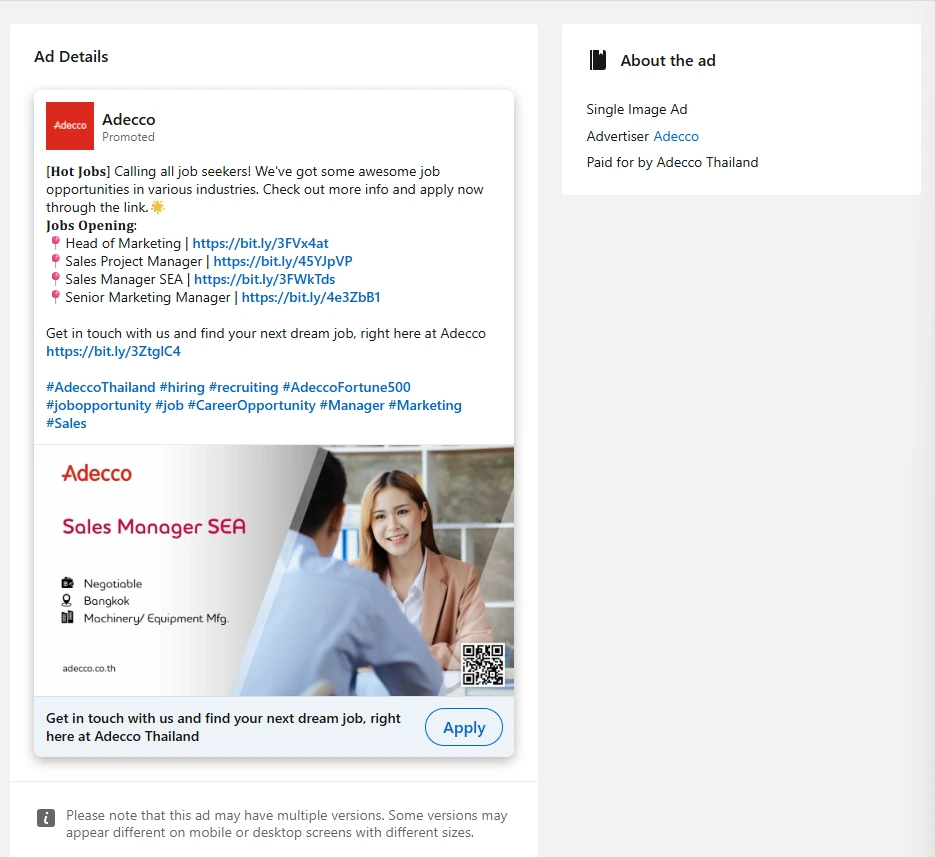
The hiring ad example by Adecco presents a concise list of current vacancies across managerial roles in sales and marketing, linking directly to individual application pages. The post uses a promotional tone aimed at attracting a broad audience of job seekers, with a focus on accessibility and variety. While it emphasizes enthusiasm and urgency through formatting and emojis, the ad lacks specific information about the roles, such as qualifications, responsibilities, or work locations, beyond the general indication that they are based in Southeast Asia (SEA). The approach is clearly mass-recruitment oriented, leveraging popular hashtags and short links to drive click-throughs, but may leave discerning applicants seeking more substantive detail before applying.
Strengths:
- Simplified Access to Roles: Grouping job openings in one post with direct application links can streamline the application process and reduce friction for job seekers.
- Use of Visual Cues: Emojis and bold formatting help draw attention to key parts of the post, though these should be balanced to maintain professionalism.
- Social Media Optimization: Use of hashtags and concise messaging is effective for platforms like LinkedIn, where discoverability and quick impressions are crucial.
- Clear Call to Action: Repeating the invitation to “get in touch” and apply reinforces engagement, although variation in language may help avoid redundancy.
- Brand Consistency: Mentioning the company multiple times and incorporating regional identifiers (e.g., "Adecco Thailand") strengthens geographic and brand association.
Areas to Improve:
- Missed Opportunity for Detail: The post could improve by including brief summaries of each role or required qualifications to attract more targeted applicants.
- Overuse of General Phrases: Generic terms like “awesome job opportunities” or “dream job” may come across as vague; specific value propositions could be more persuasive.
Hiring Ad Example: Celestify - Developers
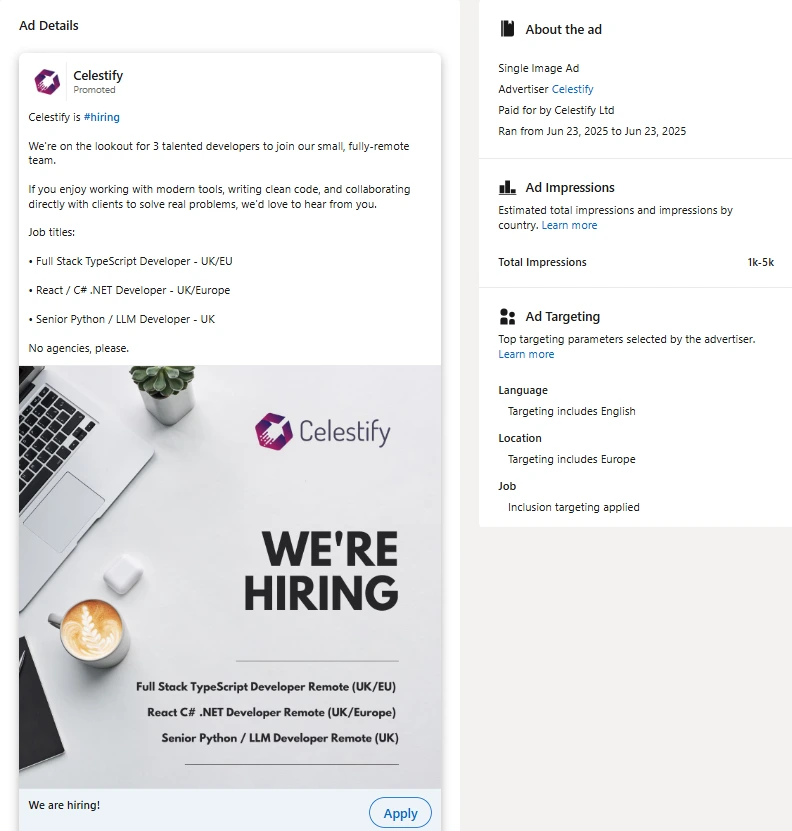
Celestify’s hiring ad communicates the availability of three remote technical roles within a small, fully distributed team, targeting candidates in the UK and EU. The language is straightforward and professional, focusing on the value of modern development practices and direct client collaboration. The roles are clearly listed, along with a preference for direct applicants (“No agencies, please”), which adds clarity around the hiring process. The ad uses minimalist design elements with clean branding and avoids excessive promotional language. However, it lacks deeper context, such as project domains, technologies beyond the stack keywords, or company culture insights, which may be relevant to experienced candidates considering startup or remote positions.
Strengths:
- Clarity of Role Titles: Clearly naming job titles and specifying remote regions (UK/EU) minimizes confusion and filters out irrelevant candidates.
- Concise and Focused Copy: The copy is short but informative, with a calm tone that respects the reader’s time while highlighting core expectations (e.g., clean code, modern tools).
- Visual Consistency: The ad design maintains a professional image without distracting visual clutter, reinforcing brand credibility.
- Transparent Hiring Preferences: Including “No agencies, please” helps streamline applicant flow and reduce recruiter overhead.
- Simple CTA Placement: The "Apply" button is visible but not overly prominent, suitable for a professional audience already inclined toward action.
Areas to Improve:
- Limited Context for Candidates: Adding a line or two about the nature of projects, company mission, or team structure could better inform candidate decisions.
- No Salary or Benefit Mentions: While optional, listing compensation ranges or perks (even approximately) is increasingly expected for transparency, especially in remote-first roles.
- Potential Geographic Ambiguity: Listing both “UK” and “UK/EU” for different roles might confuse applicants about precise eligibility unless elaborated further on the landing page.
Hiring Ad Example: Citrus Heights Water District
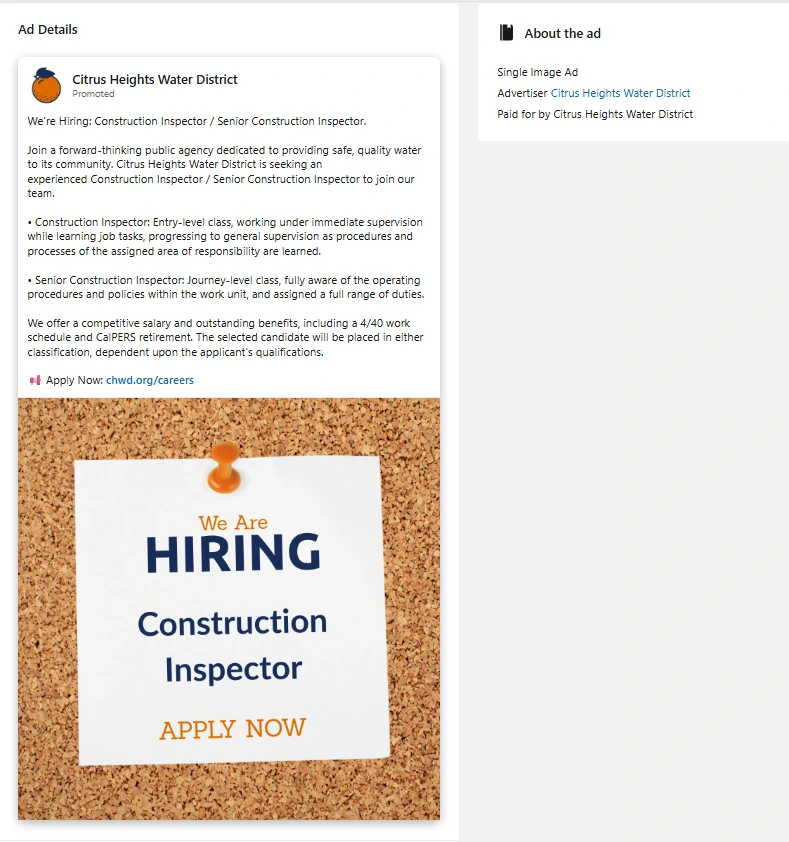
The ad from Citrus Heights Water District targets candidates for either an entry-level or journey-level Construction Inspector position, offering a clear distinction between the two classifications. The copy effectively outlines the structure of responsibilities for each level, giving potential applicants a sense of progression and fit based on experience. The ad also provides a brief but informative summary of the benefits package, highlighting work schedule flexibility and retirement planning. While the tone is community-centered and straightforward, the design remains simple, using a corkboard graphic to underscore the hiring message. However, the post might benefit from stronger visual branding and more detailed information about the work environment or organizational culture.
Strengths:
- Clarity in Job Classification: Clearly distinguishing entry-level from senior roles within one ad helps reach a broader talent pool and sets accurate expectations for applicants.
- Benefit Transparency: Mentioning specific perks, such as work schedules and retirement options, adds value for job seekers and improves employer credibility.
- Mission-Driven Framing: Referencing the organization's public service mission may resonate with candidates motivated by community impact or public sector work.
- Plain and Accessible Language: The ad uses simple, jargon-free descriptions of job duties and supervisory expectations, which improves accessibility for diverse applicants.
- Modular Positioning: Offering dual-track openings within one posting is resource-efficient and flexible, allowing HR to match the hire to applicant qualifications.
Areas to Improve:
- Basic Visual Limitation: The corkboard image is functional but visually unremarkable. Adding subtle branding or photographic context could enhance recall and engagement.
- Lack of Role-Specific Details: Including more specifics about the types of projects, tools, or environments the inspector will encounter could strengthen relevance and appeal.
Hiring Ad Example: Drakos Urgent Care - Various Positions
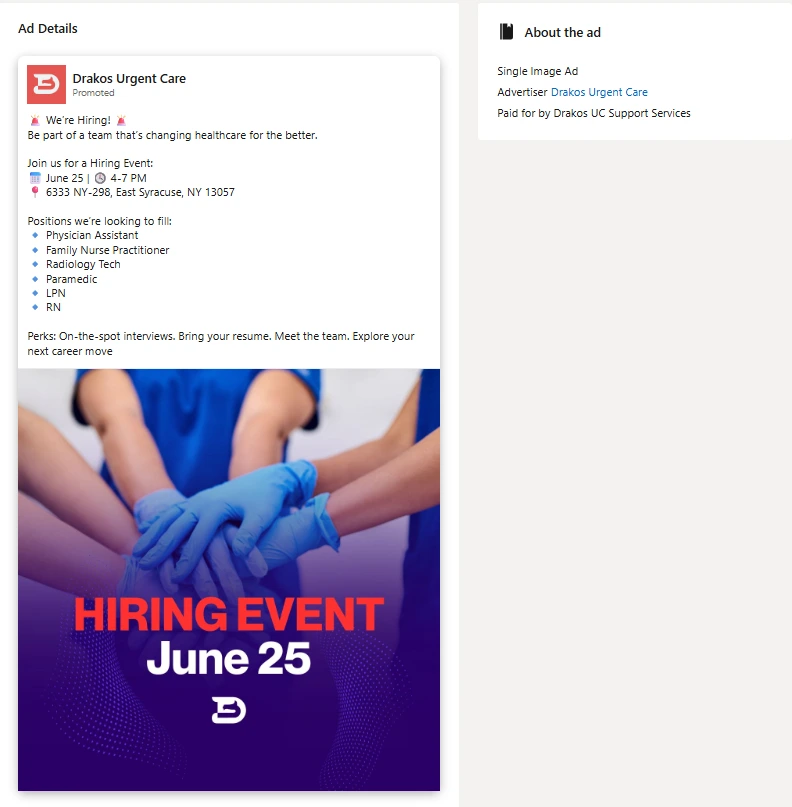
Drakos Urgent Care’s hiring advertisement promotes a walk-in recruitment event for various clinical roles, including physicians, nurses, and technicians. The ad emphasizes immediacy and convenience, highlighting the opportunity for on-the-spot interviews and direct engagement with the team. It includes essential logistical details, date, time, and location, paired with a concise list of open positions. The accompanying visual reinforces healthcare themes through gloved hands in a unified gesture, aligning with the team-centric message. While the ad communicates urgency and accessibility effectively, it does not elaborate on the workplace culture, compensation, or professional development opportunities, which could help differentiate it in a competitive healthcare labor market.
Strengths:
- Clear Event Logistics: Including specific time, date, and address details minimizes friction and supports turnout for in-person hiring events.
- Job Role Visibility: Listing open positions in a simple bulleted format allows for quick scanning and ensures that relevant candidates can self-identify.
- Event-Based Recruiting Approach: Organizing a live, on-site hiring day adds momentum and may accelerate hiring cycles, particularly in high-demand sectors like healthcare.
- Visual Reinforcement of Mission: The use of imagery (e.g., teamwork gestures with gloves) effectively supports the message of unity and care in clinical work.
- Emphasis on Direct Interaction: Phrases like “meet the team” and “on-the-spot interviews” promote transparency and reduce barriers often associated with lengthy hiring pipelines.
Areas to Improve:
- Limited Differentiation Beyond Logistics: The ad could be strengthened by including a brief statement about organizational values, benefits, or what makes Drakos Urgent Care a distinctive employer.
- No Digital Option for Non-Attendees: Providing a remote application option or a follow-up path for those unable to attend would make the opportunity accessible to a wider pool of candidates.
Hiring Ad Example: Gregory Poole Equipment Company
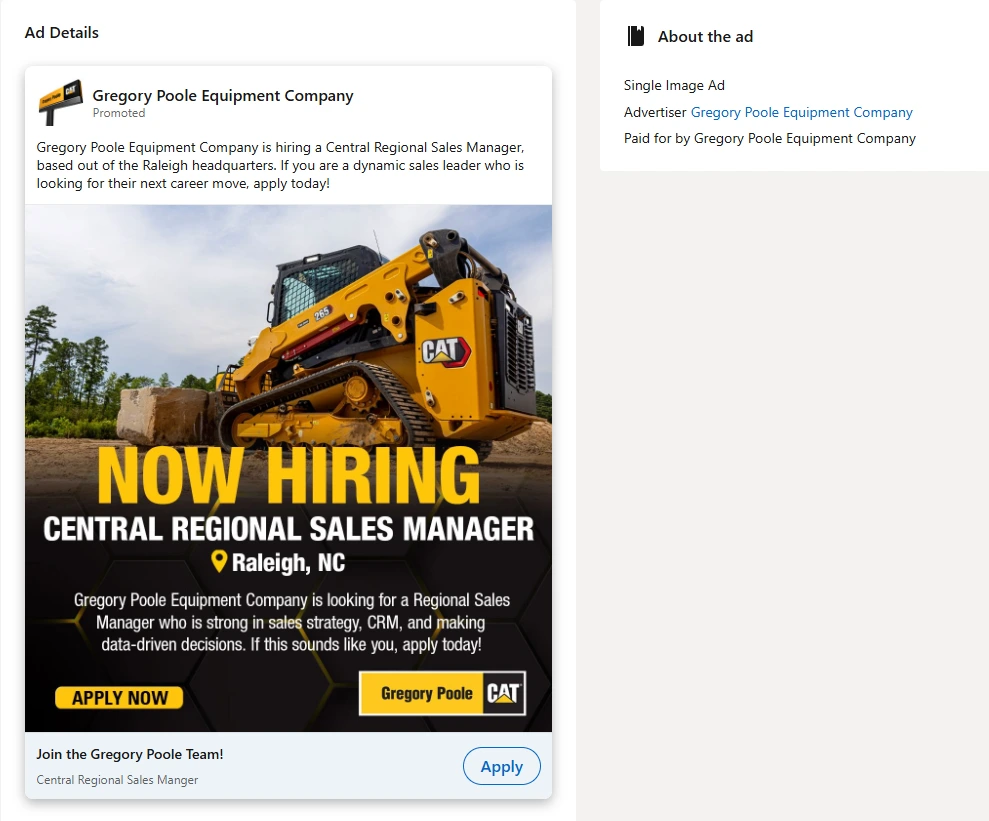
This ad by Gregory Poole Equipment Company markets an opening for a regional sales manager in Raleigh, NC, with an emphasis on qualifications such as CRM skills and data-driven decision-making. The layout is visually bold, featuring heavy machinery and large typography consistent with the company’s industrial brand. The messaging is direct and role-focused, using phrases like “dynamic sales leader” without overselling. However, details on benefits, compensation, or work culture are absent. The ad assumes the audience is already familiar with the company or its sector, which may narrow its effectiveness with broader talent.
Strengths:
- Visual Brand Consistency: Featuring the company’s core product (heavy equipment) aligns the ad with industry identity and appeals to niche talent.
- Direct and Focused Role Positioning: Highlighting key decision-making and CRM skills filters for experienced sales professionals.
- Location-Based Targeting: Clear mention of the job’s base in Raleigh, NC, improves targeting for regionally bound candidates.
- Strong CTA and Visual Hierarchy: The “Apply Now” placement and large typography direct attention effectively.
Area to Improve:
- Lacks Depth on Culture or Incentives: Including a brief note on benefits, mission, or team dynamics could expand the ad’s appeal beyond those already familiar with the brand.
Hiring Ad Example: H&G Recruitment Solutions - HGV 2 Drivers
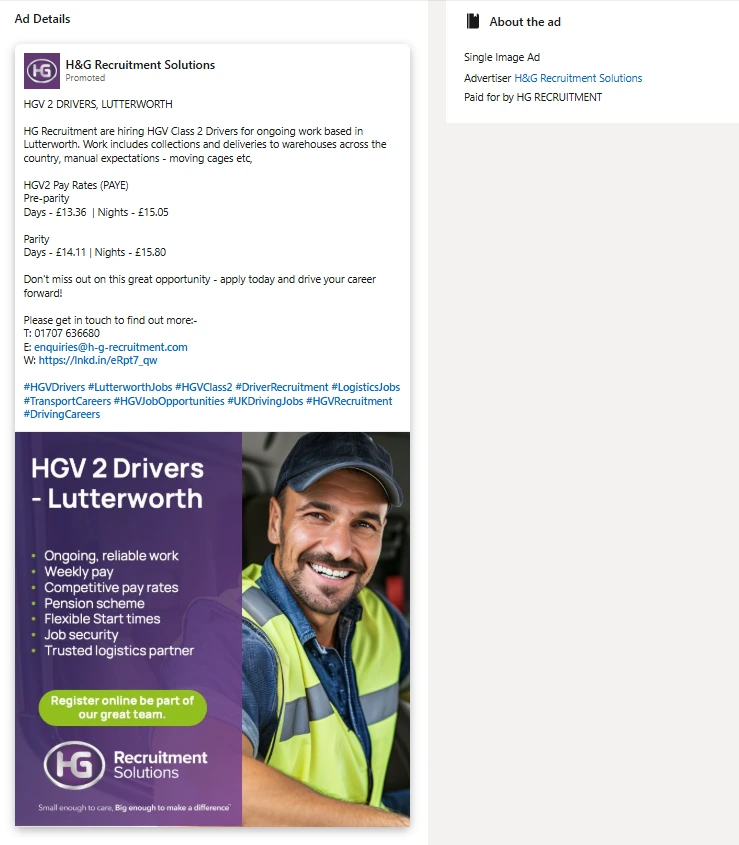
This ad by H&G Recruitment Solution is targeted toward logistics and driving professionals, with a detailed pay breakdown for both day and night shifts. The job location is clearly stated, and the image of a smiling driver supports approachability and job security themes. The inclusion of working conditions like “manual expectations” and “moving cages” shows an effort toward realism. While informative, the ad’s extensive hashtag use and call to apply may feel promotional. The lack of progression or benefits beyond pay may limit appeal to drivers seeking long-term career growth.
Strengths:
- Pay and Shift Transparency: Clearly listing pay by time period (e.g., day/night, parity) respects applicants’ time and reduces uncertainty.
- Geographic Specificity: Including exact job location, such as “Lutterworth,” ensures the ad reaches the right local audience for in-person roles.
- Realistic Work Descriptions: Mentioning physical expectations, like “moving cages,” prepares candidates accurately for job demands.
- Visual Trust Cues: Using a relatable photo of a worker in uniform can increase trust and engagement.
Area to Improve:
- Limited Advancement Language: While the role is clear, adding pathways for promotion or longevity could appeal more to career-driven candidates.
Hiring Ad Example: Jubilee Medical Services - Behavioral Health Medical Director
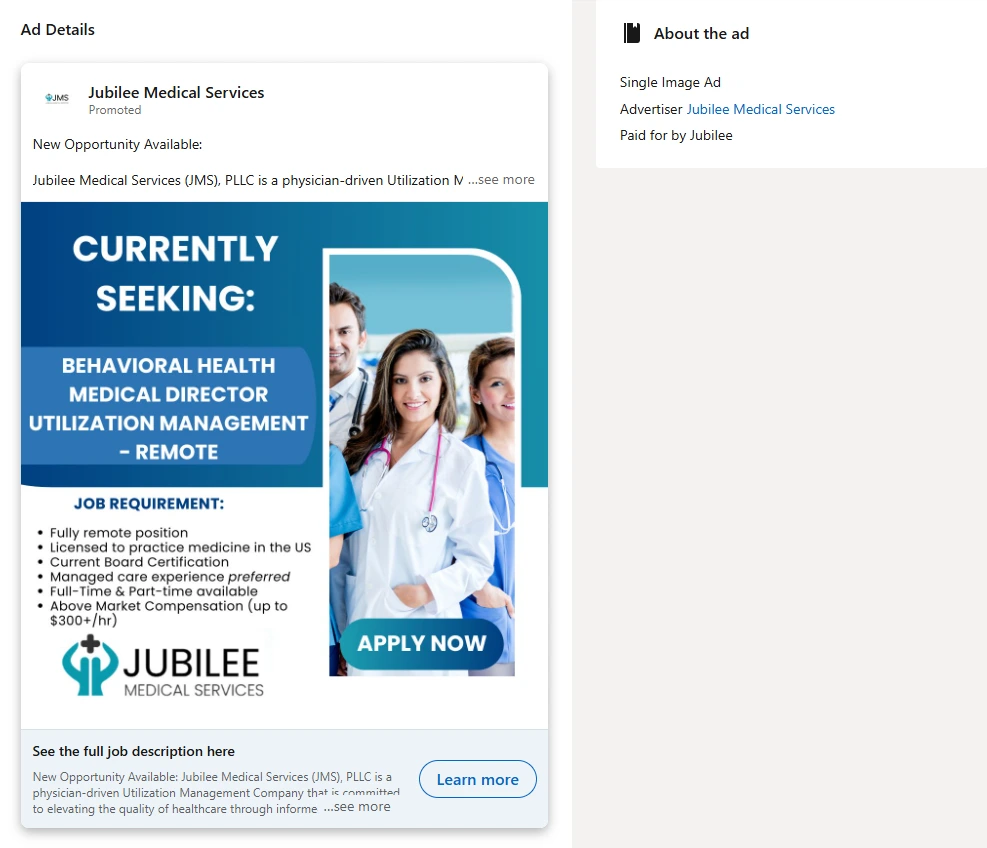
Jubilee Medical Services presents a highly structured ad aimed at attracting specialized clinical leadership talent. The role is remote, with specific requirements outlined upfront—board certification, licensure, and experience with managed care. Compensation is also mentioned transparently, which is rare but increasingly valued. The ad blends a professional tone with a graphic layout that mirrors healthcare industry standards. While formal and efficient, the ad lacks softer elements that might appeal to candidates seeking a more humanized employer brand or insights into organizational culture.
Strengths:
- Professional Design and Structure: A clear layout with formal design elements reflects well in clinical and executive-level hiring contexts.
- Transparent Qualifications and Pay: Listing requirements and compensation up front filters out unqualified applicants and can increase trust with serious candidates.
- Emphasis on Remote Flexibility: Calling out both full-time and part-time availability supports inclusion and flexibility, especially for senior-level professionals.
Area to Improve:
- Missing Cultural Narrative: Highly structured ads can benefit from humanizing elements that signal workplace values or team culture.
Hiring Ad Example: Philadelphia Federal Credit Union
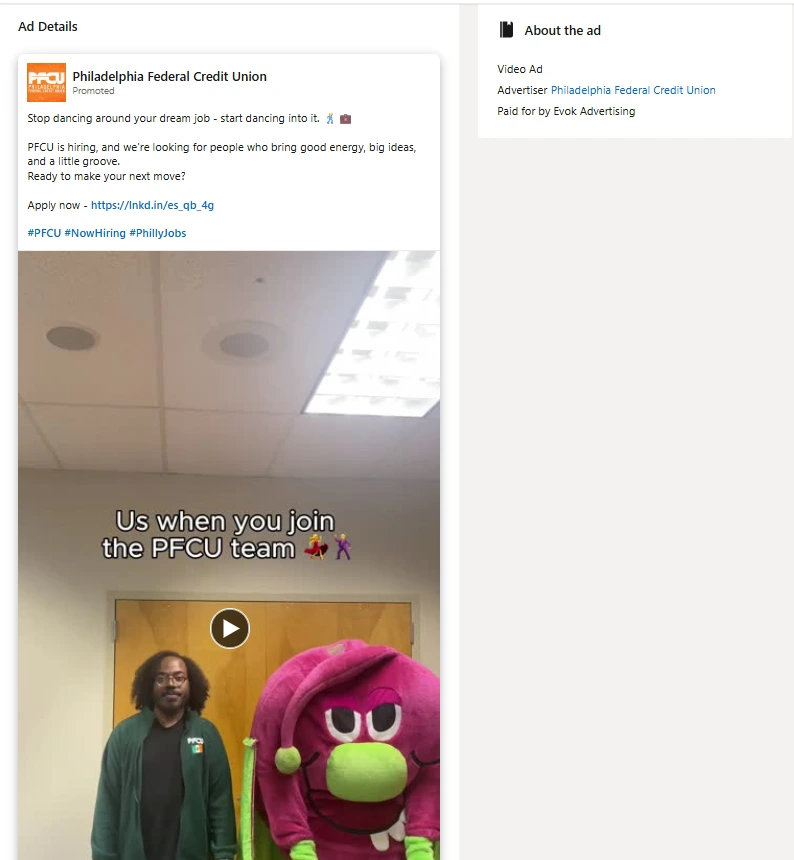
This ad from PFCU employs a casual, humorous tone with dancing mascots and informal phrasing to communicate a lighthearted company culture. The messaging emphasizes team spirit and energy over job details, using a short caption with minimal information on the roles, expectations, or benefits. As a video-based ad, it likely aims to generate attention and brand visibility rather than immediate job applications. The creative direction suggests PFCU is targeting younger or culturally engaged talent, but the absence of job-specific content may limit relevance for serious candidates looking for clear criteria or advancement prospects.
Strengths:
- Brand Personality Through Format: Using video and humor can make an organization feel approachable and relatable, especially to younger job seekers.
- Cultural Messaging vs. Role Clarity: Culture-forward messaging may boost employer brand awareness, but should be balanced with role-specific content to drive actual applications.
Areas to Improve:
- Brevity and Tone Must Be Strategic: Overly informal tone risks excluding candidates who value clarity, structure, or professionalism in job-related messaging.
- Top-of-Funnel Awareness: This type of ad functions well as a brand touchpoint, but likely requires a supporting channel (e.g., careers page) with detailed job listings.
Conclusion
Effective job advertisements do more than announce vacancies. They serve as an extension of an organization's identity and values. These eight hiring ad examples, along with the practices outlined earlier, show how tailoring your messaging to different audiences and job functions can enhance recruitment outcomes. The most compelling ads combine clarity in role expectations with a reflection of company culture, clear benefits, and thoughtful design. Businesses that invest in crafting transparent, inclusive, and well-targeted job ads are more likely to attract the right candidates and foster meaningful engagement from the start. Whether your hiring goals center on scale, specialization, or brand visibility, tailoring your message with intention and authenticity can significantly elevate your recruitment outcomes.
Frequently Asked Questions
Q: What are the essential components every job advertisement should include?
A: A job advertisement should include the job title, a concise job description, and required qualifications to attract suitable candidates. It should also provide information about the company, specify the employment type, and ideally include compensation details. Clear application instructions and deadlines are essential to streamline the hiring process.
Q: Why is it important to use objective screening criteria in job requirements?
A: Using objective screening criteria in job requirements is essential for a fair hiring process, focusing on candidates' relevant skills and experiences while minimizing biases. This approach enhances diversity, improves hire quality, and protects organizations from legal challenges by ensuring compliance with employment laws and promoting inclusivity and equity.
Q: How can I tailor job ads for specific industries or roles?
A: To create effective job ads for specific industries, research industry trends, valued qualifications, and jargon. Highlight relevant skills and experiences, use industry-specific language, and emphasize company culture. Post job ads on platforms frequented by professionals in the target sector to reach suitable candidates.
Q: What role do keywords and SEO play in making job ads discoverable?
A: Integrating relevant keywords and SEO techniques into job ads improves their visibility on search engines and job boards, helping employers reach a broader and more qualified candidate pool. This involves using industry-specific terminology, optimizing meta descriptions, and properly formatting job ads to enhance search engine ranking and improve recruitment efficiency.
Q: How do I ensure legal compliance (e.g., location-specific salary laws)?
A: To ensure compliance with location-specific salary laws, it's crucial to stay updated on regional labor regulations such as minimum wage and overtime pay. Hiring legal experts or a compliance officer can help navigate these complexities, and using HR management systems can automate payroll processes and track legal changes. Regular training for the HR team is important to maintain a legally compliant workplace, reducing the risk of non-compliance.
Citations





.png)

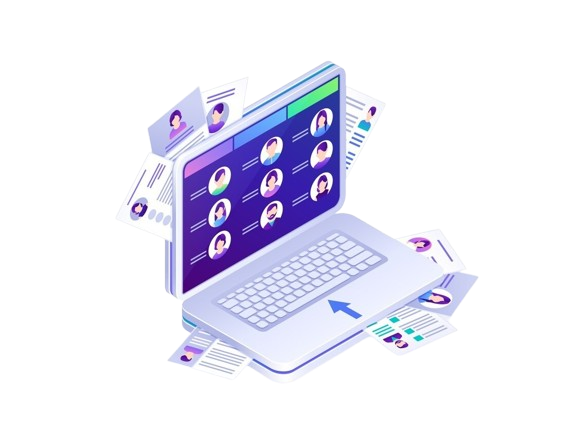









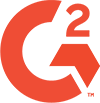


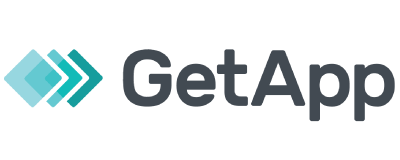







.webp)

.webp)
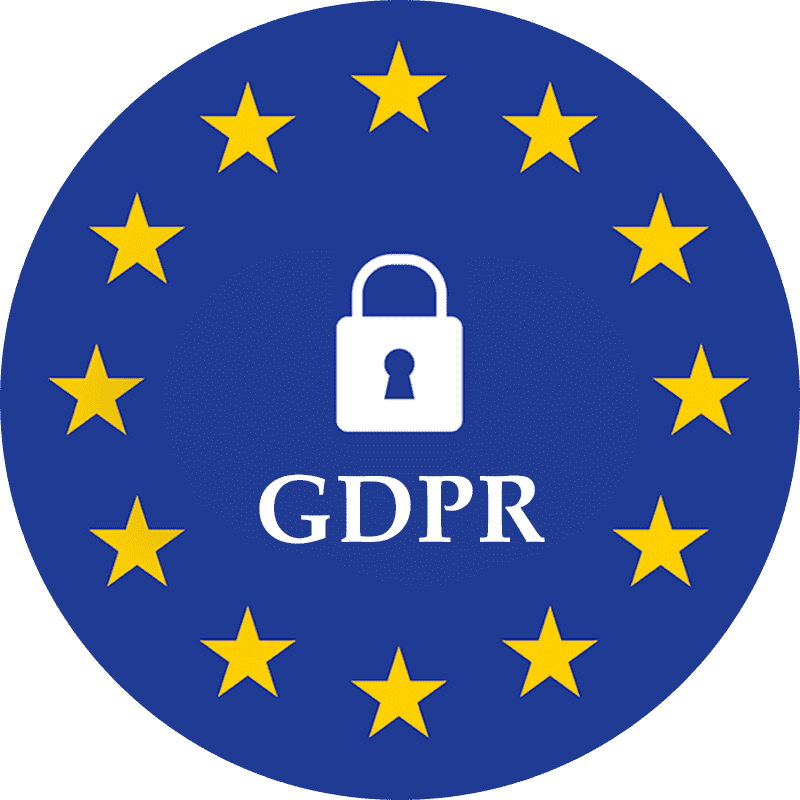
.webp)
